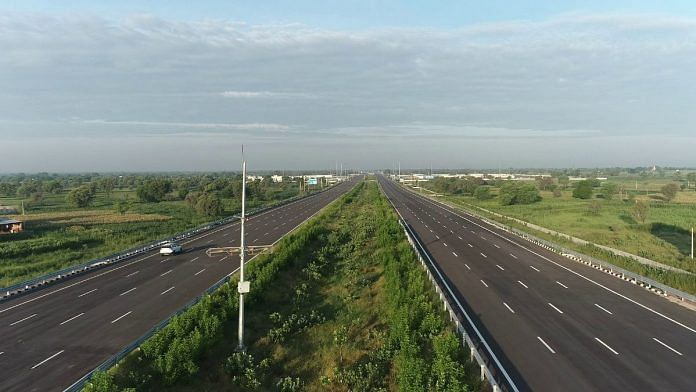New Delhi: Starting next week, you will be able to reach Jaipur from Delhi within about four hours instead of six as the first phase of the 1,386 km greenfield Delhi-Mumbai expressway connecting the national capital to Rajasthan’s Dausa becomes operational.
Prime Minister Narendra Modi will be inaugurating the 229 km Sohna (Haryana)-Dausa-Lalsot (Rajasthan) stretch at Dausa on 12 February. Rajasthan goes to polls later this year.
The Delhi-Mumbai expressway will start from Alipur village near Sohna. It will connect to Delhi through the Delhi-Gurgaon expressway. At Dausa, the existing national highway between Agra-Jaipur will provide connectivity to Jaipur.
A senior official of the Ministry of Road Transport and Highways told ThePrint that the entire 1,386 km Delhi-Mumbai expressway is expected to become operational by 2024 and will reduce the travel time between the national capital and India’s commercial capital by half — to 12 hours from the current 24 hours.
The access controlled eight-laned highway is being built at an estimated cost of Rs 98,000 crore, and can be expanded to 12 lanes if required, according to the ministry document.
The expressway will connect Delhi to Jewar Airport in Uttar Pradesh and Jawaharlal Nehru Port in Mumbai and will improve connectivity to economic hubs in six states: Delhi, Haryana, Rajasthan, Madhya Pradesh, Gujarat, and Maharashtra.
“So far we have awarded 1,368 km and it is under implementation,” the official said.
While the first phase from Delhi-Dausa will be opened to traffic from 12 February, the Vadodara-Ankleshwar stretch will be completed by April 2023.
Though no toll will be charged initially, once fully operational, the one way toll for cars, fixed by NHAI, will be Rs 390.
Also Read: Budget 2023: Capital outlay sees 33% hike in infra boost. Focus on Nal Se Jal, PM Awas scheme
1st expressway to have animal overpasses
The expressway is the first in Asia and only the second in the world to feature animal overpasses to facilitate unrestricted movement of wildlife. There will be three animal overpasses and five underpasses with a combined length of 2.5 km, dedicated for unencumbered wildlife movement.
An official of National Highways Authority of India (NHAI) said the alignment (route) was chosen in a way to minimise impact on the Ranthambore wildlife sanctuary.
Besides, it will also have two eight-lane tunnels, one will pass through Mukundra sanctuary (Rajasthan) without disturbing the endangered fauna in the region for 4 km, and the second 4 km eight-lane tunnel will pass through the Matheran eco-sensitive zone (Maharashtra).
There will also be a three-feet tall boundary wall and dedicated sound barriers to increase safety of animals in wildlife sections.
Also Read: Modi finds lotus a common thread between him, G20 & Gujjar deity: ‘We’re the ones born with lotus’
15,000 hectares acquired across 5 states
The NHAI has acquired approximately 15,000 hectares of land across five states for the 1,386 km expressway, touted as India’s longest. But because it’s a greenfield alignment, the total land acquisition cost is approximately 25 per cent of the total project cost, way cheaper than brownfield expressways.
A greenfield expressway is one which is built on a completely new alignment.
The project was conceptualised in March 2018 while the foundation stone was laid by Union Highways Minister Nitin Gadkari on 9 March 2019.
On the 1,386 km stretch, there are over 40 major interchanges to provide connectivity to Kota, Indore, Jaipur, Bhopal, Vadodara and Surat, according to information shared by the ministry.
There will be 94 way side amenities on the entire stretch including restaurants, dormitories, hospitals, food courts and fuel stations.
The expressway will also have three-metre wide dedicated corridor for laying utility lines including optical fibres cables, pipelines and solar power generation and a state of the art automated traffic management system.
According to road ministry officials, once ready the expressway will give a leg up to the economy of the region by generating employment. The Delhi-Mumbai expressway is part of the 17 greenfield corridors proposed in Phase-I of the Bharatmala Pariyojana with an overall length of more than 9,000 kms with an estimated cost of Rs 4 lakh crore.
Currently, five greenfield expressways of 2,500 km length are under implementation and will be ready by 2025. These include the 109 km Ahmedabad-Dholera, 262 km Bengaluru-Chennai, 669 km Delhi-Amritsar-Katra, 63 km Kanpur-Lucknow expressways.
(Edited by Anumeha Saxena)
Also Read: ‘Govt chose capex route for its great multiplier effect,’ Nirmala Sitharaman tells Lok Sabha



